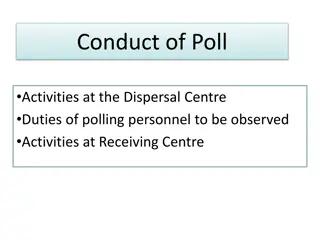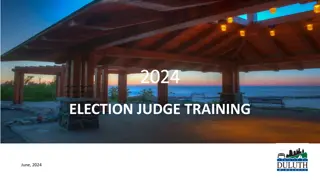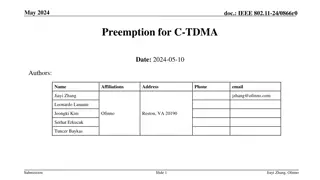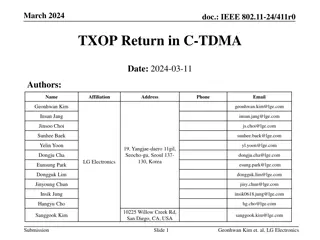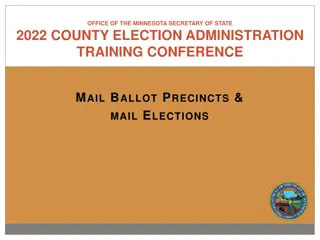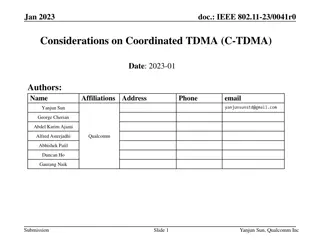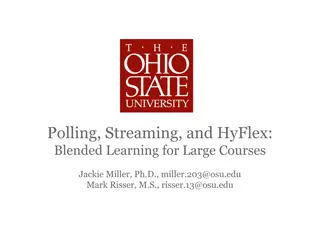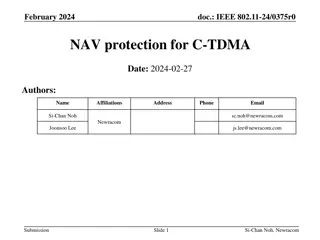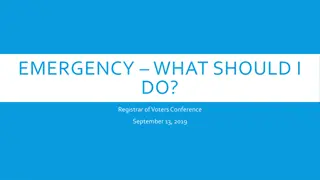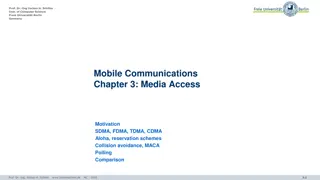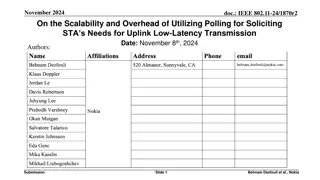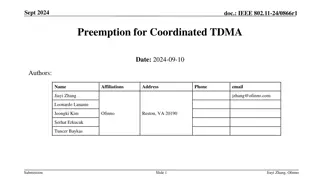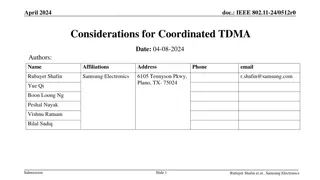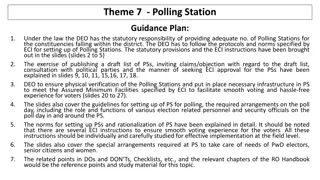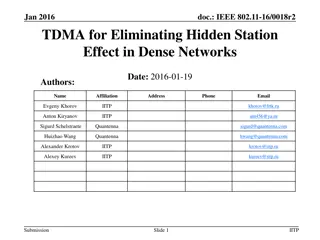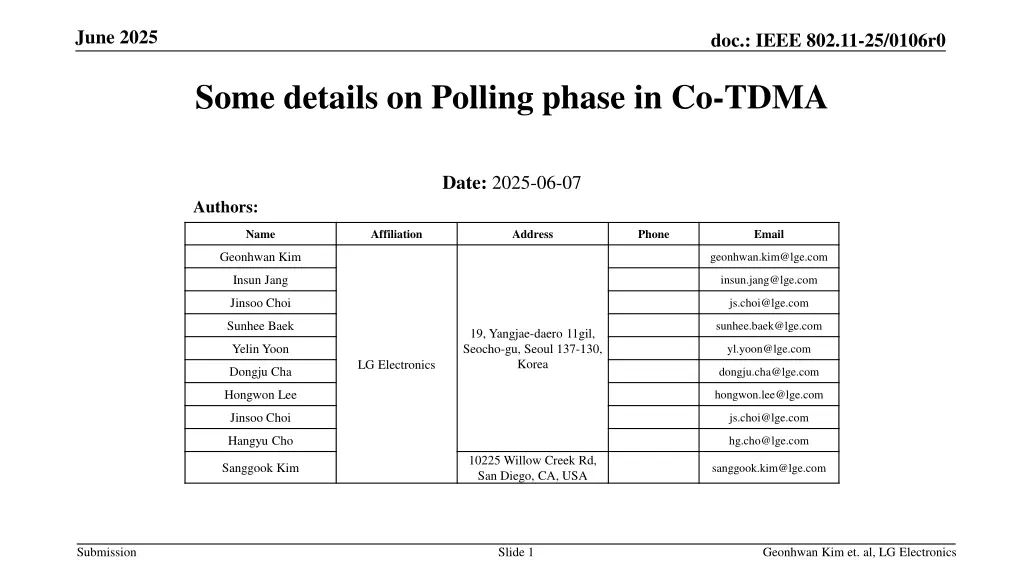
Detailed Explanation of Polling Phase in Co-TDMA Procedure
Learn about the polling phase in Co-TDMA protocol as discussed in the June 2025 document IEEE 802.11-25/0106r0. The three main phases - polling, TXOP allocation, and TXOP return - are explained in detail, along with insights on ICF/ICR information, additional feedback information, and failure handling strategies.
Download Presentation

Please find below an Image/Link to download the presentation.
The content on the website is provided AS IS for your information and personal use only. It may not be sold, licensed, or shared on other websites without obtaining consent from the author. If you encounter any issues during the download, it is possible that the publisher has removed the file from their server.
You are allowed to download the files provided on this website for personal or commercial use, subject to the condition that they are used lawfully. All files are the property of their respective owners.
The content on the website is provided AS IS for your information and personal use only. It may not be sold, licensed, or shared on other websites without obtaining consent from the author.
E N D
Presentation Transcript
June 2025 doc.: IEEE 802.11-25/0106r0 Some details on Polling phase in Co-TDMA Date: 2025-06-07 Authors: Name Affiliation Address Phone Email Geonhwan Kim geonhwan.kim@lge.com Insun Jang insun.jang@lge.com Jinsoo Choi js.choi@lge.com Sunhee Baek sunhee.baek@lge.com 19, Yangjae-daero 11gil, Seocho-gu, Seoul 137-130, Korea Yelin Yoon yl.yoon@lge.com LG Electronics Dongju Cha dongju.cha@lge.com Hongwon Lee hongwon.lee@lge.com Jinsoo Choi js.choi@lge.com Hangyu Cho hg.cho@lge.com 10225 Willow Creek Rd, San Diego, CA, USA Sanggook Kim sanggook.kim@lge.com Submission Slide 1 Geonhwan Kim et. al, LG Electronics
June 2025 doc.: IEEE 802.11-25/0106r0 Introduction Based on the recent 11bn Draft 0.2, the expected Co-TDMA procedure between the 3 APs is as follows [1]: SIFS SIFS SIFS SIFS SIFS SIFS TXOP allocation to AP3 using an MU-RTS TXS Trigger frame AP1 ICF (Co-TDMA Sharing AP) Frame exchange(s) between AP1 and its STA(s) Time Response to AP1 AP2 Time CTS TXOP return to AP1 response to AP1 Response to AP1 AP3 Frame exchange(s) between AP3 and its STA(s) Time Polling phase TXOP allocation phase TXOP return phase There are three main phases in Co-TDMA. Polling [2, 3] TXOP allocation [4] TXOP return [5, 6] It is time to discuss in more detail each of the steps proposed for further progress of Co-TDMA. Submission Slide 2 Geonhwan Kim et. al, LG Electronics
June 2025 doc.: IEEE 802.11-25/0106r0 Recap: ICF/ICR in Co-TDMA The May F2F meeting determined how to include Co-TDMA information in ICF/ICR [7]. Co-TDMA TB ICF delivers a Feedback User Info field (2008) with the Feedback Type field set to 3. Co-TDMA NTB ICF includes a Feedback Type and Feedback Info in User Info field (AP ID). Contents in ICF: Primary AC and TXOP Return Solicited The ICR sent from the polled AP contains Co-TDMA information by setting the AID11 field to a value other than 2045, the Ack Type field to 0, the TID field to 13, and the Feedback Type field to Co-TDMA (set to 3). Contents in ICR: TXOP Sharing Solicited Additional information that may be useful for Co-TDMA can be included in the ICF/ICR. Submission Slide 3 Geonhwan Kim et. al, LG Electronics
June 2025 doc.: IEEE 802.11-25/0106r0 Additional Info within Co-TDMA ICF/ICR The Feedback Information field in the ICF can contain a Maximum TXOP Duration. Maximum TXOP Duration: The expected allocatable TXOP duration. The expected allocatable TXOP duration helps polled APs request the TXOP duration they need via ICR. The Feedback Information field in the ICR can include Required TXOP Duration and LLT Requirements. Required TXOP Duration: The explicit duration of TXOP required. This duration shall be shorter than the Maximum TXOP Duration provided by the Co-TDMA sharing AP. LLT Requirements: Final sharing timing (or time limits) required for LLT transmission. It may be replaced with an additional Per AID TID Info field with Feedback Type field set to 1 (LLT). Submission Slide 4 Geonhwan Kim et. al, LG Electronics
June 2025 doc.: IEEE 802.11-25/0106r0 Failure handling in the Polling phase Co-TDMA sharing AP transmits TB (or) NTB ICF at the beginning of the TXOP. The Duration field is set to the time required to transmit the solicited response from the polled AP(s) plus one SIFS. Since ICF is the first frame transmitted without any protection after obtaining TXOP, a situation may occur where the polled AP(s) cannot respond due to the NAV of the third-party STA (hidden from the sharing AP). Therefore, the polling phase of Co-TDMA requires appropriate handling of transmission failure. If the transmission of all MPDUs in the initial PPDU of a TXOP fails and the PPDU contains an MPDU that solicits TB PPDU, the backoff procedure shall be invoked (10.23.2.2 EDCA backoff procedure). Failure of ICF/ICR exchange results in loss of transmission opportunity of the Co-TDMA sharing AP and waste of medium. PIFS recovery may be performed to ensure TXOP and to exchange ICF/ICR successfully. If an Co-TDMA sharing AP transmits an ICF in an initial PPDU of a TXOP and the ICF transmission fails, then the AP might perform a PIFS recovery or invoke the backoff procedure. Additionally, Co-TDMA sharing AP may choose one of the following: Retransmit ICF Transmit another frame (for In-BSS frame exchange) Submission Slide 5 Geonhwan Kim et. al, LG Electronics
June 2025 doc.: IEEE 802.11-25/0106r0 NAV Issues (1/2) When TXOP is returned, NAV issues may occur for third-party STAs and STAs associated with the Co- TDMA sharing AP. Submission Slide 6 Geonhwan Kim et. al, LG Electronics
June 2025 doc.: IEEE 802.11-25/0106r0 NAV Issues (2/2) To avoid NAV issues, the Duration field of frames transmitted by the Co-TDMA coordinated AP during the allocated time can be set to 0 (i.e., example in figure below). Alternatively, the Co-TDMA coordinated AP can set the Duration field of its frame(s) to a value for a single protection setting (e.g., ) or the value until Ack is received for the TXOP return frame (e.g., ). Submission Slide 7 Geonhwan Kim et. al, LG Electronics
June 2025 doc.: IEEE 802.11-25/0106r0 Summary In this contribution, we discussed additional information for Co-TDMA ICF/ICR as follows: Maximum TXOP Duration in ICF Required TXOP Durationand LLT Requirements in ICR Since ICF is the first frame transmitted after obtaining TXOP, proper handling of transmission failures seems required. Finally, we propose a rule for setting the Duration field during the allocated time to avoid NAV issues due to TXOP returns. Submission Slide 8 Geonhwan Kim et. al, LG Electronics
June 2025 doc.: IEEE 802.11-25/0106r0 References [1] Draft P802.11bn_D0.2 [2] 24/1016, C-TDMA Follow-up: Additional Details on Framing Sequence [3] 24/1912, Coordinated TDMA Procedure [4] 24/1250, Discussion on TXOP Allocation in C-TDMA [5] 24/0411, TXOP Return in C-TDMA [6] 24/1017, Mechanism for TXOP Return in C-TDMA [7] 25/0755r11, PDT-MAC-Co-TDMA-CR-CC50-Part-2 Submission Slide 9 Geonhwan Kim et. al, LG Electronics
June 2025 doc.: IEEE 802.11-25/0106r0 Straw Poll 1 Do you agree to add the following text to the TGbn SFD? The Feedback Information field with the Feedback Type set to 3 (i.e., Co-TDMA) shall include the following: Maximum TXOP Duration: Indicates the expected TXOP duration that a Co-TDMA sharing AP can allocate. Submission Slide 10 Geonhwan Kim et. al, LG Electronics
June 2025 doc.: IEEE 802.11-25/0106r0 Straw Poll 2 Do you agree to add the following text to the TGbn SFD? The Feedback Information field of the Feedback Per AID TID Info field with AID11 field set to a value other than 2045, the Ack Type field set to 0, the TID field set to 13, and the Feedback Type field set to 3 of the Multi-STA Block Ack shall include the following: Required TXOP Duration: Indicates the explicit TXOP duration required by the polled AP. Submission Slide 11 Geonhwan Kim et. al, LG Electronics




